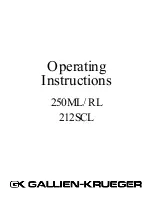
14
| JL Audio - 500/1
v2
Owner’s Manual
15
APPENDIX B:
500/1v2 Specifications
General Specifications:
Recommended Fuse Value:
50A
Recommended Fuse Type:
AFS, AGU or MaxiFuse™
Input Section:
Input Type:
Differential-balanced with RCA jack inputs
Input Range:
Switchable from 200mV - 2V RMS to
800mV - 8V RMS
Amplifier Section:
Amplifier Topology:
H-Bridge, Class D Mono
with impedance optimization and patented
discrete drive circuitry
Power Supply:
Pulse width modulation-regulated
switching power supply
Rated Power:
500W RMS x 1 @ 1.5 - 4Ω (11 - 14.5V)
THD at Rated Power:
<0.05% @ 4Ω, 50 Hz
Signal to Noise Ratio:
>95 dB referred to rated power
(A-weighted, 20 Hz - 20 kHz noise bandwidth)
Frequency Response:
5 - 250 Hz (+0, -3 dB)
Damping Factor:
>500 @ 4Ω/50 Hz, >250 @ 2Ω/50 Hz
Crossover Section:
Amplifier Low-Pass Filter
: State-variable, 12 dB/octave
Butterworth or 24 dB/octave Linkwitz-Riley with
continuously variable cutoff frequency selection
from 40 - 200 Hz, defeatable
Preamp Output:
2-Channel, with fully independent, state-variable,
12 dB/octave Butterworth or 24 dB/octave Linkwitz-Riley
filter with continuously variable cutoff frequency selection
from 40 - 200 Hz, defeatable
Advanced Bass Control Section
:
Parametric EQ:
Single-band, fully parametric equalizer
with “Q” adjustment from 0.5 - 4.0, center frequency
adjustment from 20 - 80 Hz, boost adjustment from
0 to +15dB and port for optional remote bass
boost control (RBC-1), defeatable
Infrasonic Filter:
Fully variable, 24 dB/octave Butterworth
high-pass filter, cutoff frequency adjustable from 15 - 60
Hz, defeatable
Dimensions (LxWxH):
13.4" x 9.25" x 2.27" (340mm x 235mm x 58mm)
Nom. Impedance
Target AC Voltage
4Ω
(or higher)
44.7V
3Ω
38.7V
2Ω
31.6V
1.5Ω
27.4V
APPENDIX A:
Input Sensitivity Level Setting
+-"VEJPBNQMJGJFSTVUJMJ[JOHUIF3FHVMBUFE
Intelligent Power Supply (R.I.P.S.) allow
delivery of their rated power when connected
to any load impedance from 1.5 - 4Ω per
channel and when connected to a charging
system with any voltage from 11 - 14.5V. This
design is beneficial for many reasons. One of
these reasons is ease of setup. Because each
JL Audio amplifier will always deliver the
same amount of power within its operational
range of impedances and supply voltages, the
maximum, unclipped output is very predictable.
This makes setting the gain structure via the
input sensitivity controls very simple. Following
the directions below will allow the user to adjust
the input sensitivity of the amplifier(s) simply
and easily in just a few minutes using equipment
which is commonly available in installation bays.
Necessary Equipment
t%JHJUBM"$7PMUNFUFS
t$%XJUIBTJOFXBWFUFTUUPOFSFDPSEFEBU
0 dB reference level in the frequency range
to be amplified for that set of channels
)[GPSTVCXPPGFSDIBOOFMTL)[GPS
a midrange application). The CleanSweep®
$BMJCSBUJPO%JTDDPOUBJOTUIFBQQSPQSJBUF
test tones and is available for sale at
http://store.jlaudio.com
%POPUVTFBUUFOVBUFE
test tones (-10 dB, -20 dB, etc.).
The Nine-Step Procedure
1)
%JTDPOOFDUUIFTQFBLFS TGSPNUIF
amplifier’s speaker output connectors.
2)
Turn off all processing (bass/treble, loudness,
EQ, etc.) on the source unit, processors (if
used) and amplifier. Set fader control to center
position and subwoofer level control to 3/4 of
maximum (if used to feed the 500/1v2).
3)
Switch the
i
Input Voltage
w
switch to
i
Low
w
and turn the
i
Input Sens.
w
control all the
way down.
4)
Set the source unit volume to 3/4 of full
volume. This will allow for reasonable gain
overlap with moderate clipping at full volume.
5)
Using the chart on this page, determine the target
voltage for input sensitivity adjustment according
to the nominal impedance of the speaker system
connected to the amplifier outputs.
6)
Verify that you have disconnected the speakers
before proceeding. Play a track with an
appropriate sine wave (within the frequency
range to be amplified by the 500/1v2) at 3/4
source unit volume.
7)
Connect the AC voltmeter to the speaker output
connectors of the amplifier. If the channel
pair is operating in stereo, it is only necessary
to measure one channel. If bridged, make sure
you test the voltage at the correct connectors
(L+ and R–).
8)
Increase the
i
Input Sens.
w
control until the
target voltage is observed with the voltmeter.
9)
Once you have adjusted the 500/1v2 to
its maximum low-distortion output level,
reconnect the speaker(s). The
i
Input Sens.
w
control can now be adjusted downward if the
amplifier requires attenuation to achieve the
desired system balance.
I M P O RTA N T
!
Do not increase any “Input Sens.” setting
for any amplifier channel or channel
pair in the system beyond the maximum
level established during this procedure.
Doing so will result in audible distortion
and possible speaker damage.
It will be necessary to re-adjust the
i
Input Sens.
w
for the affected channels if any
FRVBMJ[FSCPPTUJTBDUJWBUFEBGUFSTFUUJOHUIF
i
Input Sens.
w
with this procedure. This applies
to any EQ boost circuit, including source unit
tone controls or EQ circuits. EQ cuts will not
require re-adjustment.
Due to ongoing product development, all specifications are subject to
change without notice.































